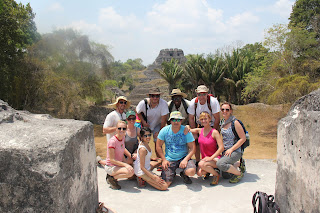Happy Tuesday, Morton Belizers:
Today, we traveled to Dangriga,
Belize. On the way, we stopped by the
Belize Zoo and saw many of the native animals that I discussed in yesterdays
message. My favorite were the big
cats! I am attaching a picture of Junior
Buddy, a six-year old Jaguar who was born at the zoo, and was absolutely
beautiful. We were actually able to get
into a smaller cage within his cage to get close enough to him and feel his
fur. I have a video of him licking my
head last year, so I will have to dig it out to share with you.
Excellent questions today, everyone. I have so much more that I could have talked
about with each of these, and I look forward to talking with you in person to
discuss more about them. For now, here
is a brief explanation.
Question 1: What was the most important ritual? It appears that there was no one single
ritual that was more important than another.
However, one that shows up often in stone carvings is the ritual of
sacrifice to keep the Gods from getting angry.
There were well over 100 Gods and Goddesses that the Mayans believed
in. Of the most important were the God
of rain and harvest (Chak), fertility (Ix-Chel), and creation (Itzamna). For example, if Chak, the rain God was angry,
then the people might suffer drought, or even flooding and destroy their
crops. They needed to keep Chak happy,
and this sometimes meant giving offerings of pottery, food, clothing, or sometimes
offering the blood or even soul of a person.
The rituals of worship were very important for the Mayan people.
Question 2: What do you know about the game pok-a-tok
that they played in the ancient ball court and did you always die
if you lost? Ball court
ruins have found in each of the Mayan city-centers. Attached is a picture we took of the ball
court at Xunantunich (in the background).
I will find a better picture to show you. The rules have been loosely defined, but it
seems that each city-center had different rules of the game, based on the
layout of the courts and the stone carvings representing the games. These carvings depict a game that was played
with a very heavy rubber ball made from the sap of rubber trees. Players had to use their elbows, shoulders,
hips and knees to get the ball into a series of hoops to score points. Sounds like a cross between basketball and
soccer, doesn’t it?

Many of
these games were played with high stakes:
death. You might think that the
losers were the ones who were killed after the game, but surprisingly, there is
also evidence that the winners were killed after the game. This is hard to understand, but there was
significant spiritual meaning to winning the game. This message will get very long if I continue
to elaborate, so it might be best for me to discuss this in person when I come
visit on June 3rd. Just know
that winning, and therefore being sacrificed to the Gods was a major honor for
the Mayan people, and therefore the players played their hardest to be the
winners, and then be offered to the Gods in sacrifice. So, to answer your question, when the games
had high spiritual implications, it could have been either the losers or the
winners that were killed after the game.
We can discuss this more soon.
Question 3: Do you have any update on the destruction of
that monument? I have not
heard any updated information. That site
is a few hours north of where we are. I
do know that the landowners and construction workers could face up to 10 years
in prison and 10 thousand dollars fine if they are convicted of willfully
destroying the temple. Since it is
already political, that might not even happen.
Sad but true.
Tomorrow, we are working in the city of
Dangriga with the town council to determine what open spaces they have and what
they can do to improve the space for public use. After this work, we are packing up and taking
a 45 minute boat ride to South Water Caye, a very small (about 9 acres) island
on the Belize Barrier Reef… the second largest barrier reef in the world,
second only to the Great Barrier Reef in Australia. We will be staying two nights on the island
working with the South Water Caye Marine Reserve and the Smithsonian Institution
Marine Research Station on nearby Carrie Bow Caye. While there is solar powered internet on
South Water, it is very weak. I will do
my best to answer your emails over the next two nights. If you do not hear from me, you’ll understand
that the internet wasn’t strong enough to get the message out.
Until you hear from me again, enjoy
learning about Belize and the Mayan people.
I’m looking forward to hearing from you!
Dr. Chris Atchison
Georgia State University







